How To Improve Grip Strength: 16 Best Grip Exercises
Author:
Unlock your full potential by engaging with our experts and community! Have questions about your fitness journey or looking for expert advice on weightlifting techniques? Don’t hesitate — leave a comment below and Sergii Putsov will provide a personalized answer and insights to help you reach your goals.
Torokhtiy is reader-supported. Some links are affiliate links, and we may earn a commission at no extra cost to you. See our disclosure page for details.
Need some professional advice on improving your grip strength to preserve hand power and vouch for decent performance? Let’s explore several tips for improving your grip strength, which is key to maintaining your overall well-being and physical condition.
Make sure that grip strength training will bring a huge difference in your everyday exercising routine, e.g., practicing grip-strengthening activities for your weekly strength-training workouts. So, here’s your complete guide to getting a firm grip, and a longer and healthier life.
Here’s a short answer on how to improve grip strength at home: as grip strength is an everyday function, perform movements like holding things of different sizes. If you’re training regularly, try using different grips, both open and closed. Also, focus on strengthening your lower arm and upper body muscles.
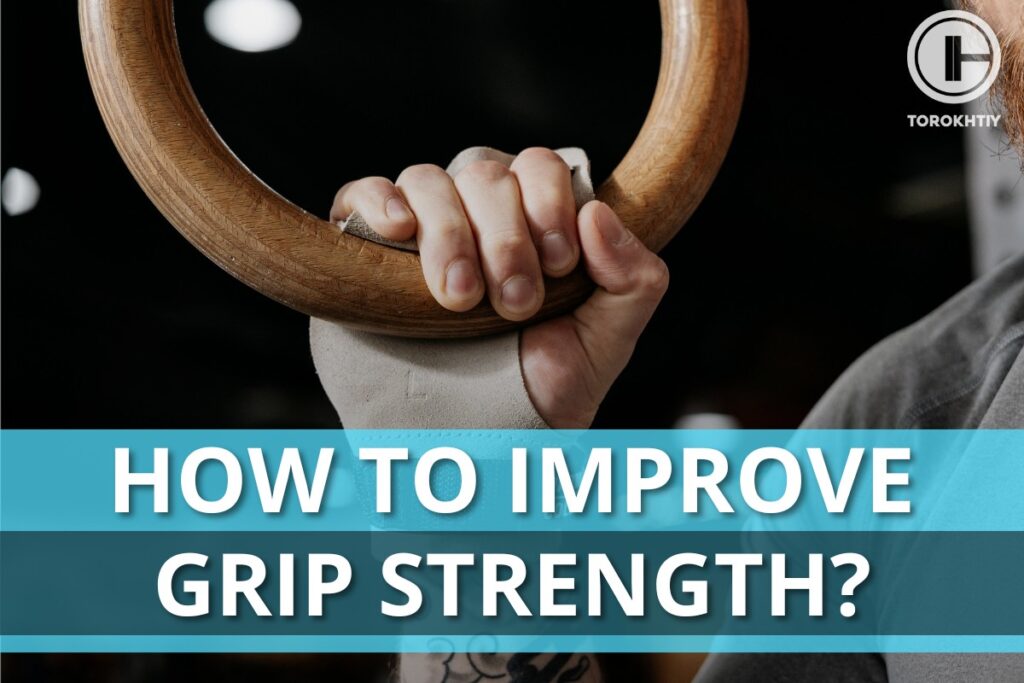
Grip Strength Importance
A strong grip is essential for playing any sports and doing household chores. However, with age, our muscles become weaker, as well as grip strength, so it’s crucial to follow a regimen of strength-training exercises to counter these effects, and keep your hands in shape.
Grip strength is the maximum force you can generate with the help of your forearm muscles. Grip strength allows you to hang, hold on things, and pull both horizontally and vertically. From the technical viewpoint, it’s the force your hand and upper body can produce by closing a fist. Also, grip strength is an easy way to assess your upper body strength.
Being a true indication of your overall health state, grip strength is connected to the immune system, namely, it shows whether we’re prone to infections, more vulnerable to getting sick, and have more complications after the illness [2]. A poor grip also showcases the signs of chronic diseases.
1. Grip Role In Sport
Grip strength refers closely to the muscle strength throughout the body affecting your mobility, balance, and endurance. That’s why grip strength contributes greatly to an athlete’s successful performance. Without sufficient grip strength, athletes will fail to perform at their highest level during their training drills and competitions.
Grip strength allows controlling the used equipment and prevents injuries by keeping the athlete’s hand from slipping. You can improve your grip with regular training.
For instance, baseball players need to have a firm grip for each swing, weightlifters to perform difficult lifts, and basketball players – to handle the ball.
Arm wrestlers, climbers, powerlifters, bodybuilders, and MMA fighters also need a strong grip to control their opponents. Strongmen and cross-training athletes also recognize the importance of strong hand grip.
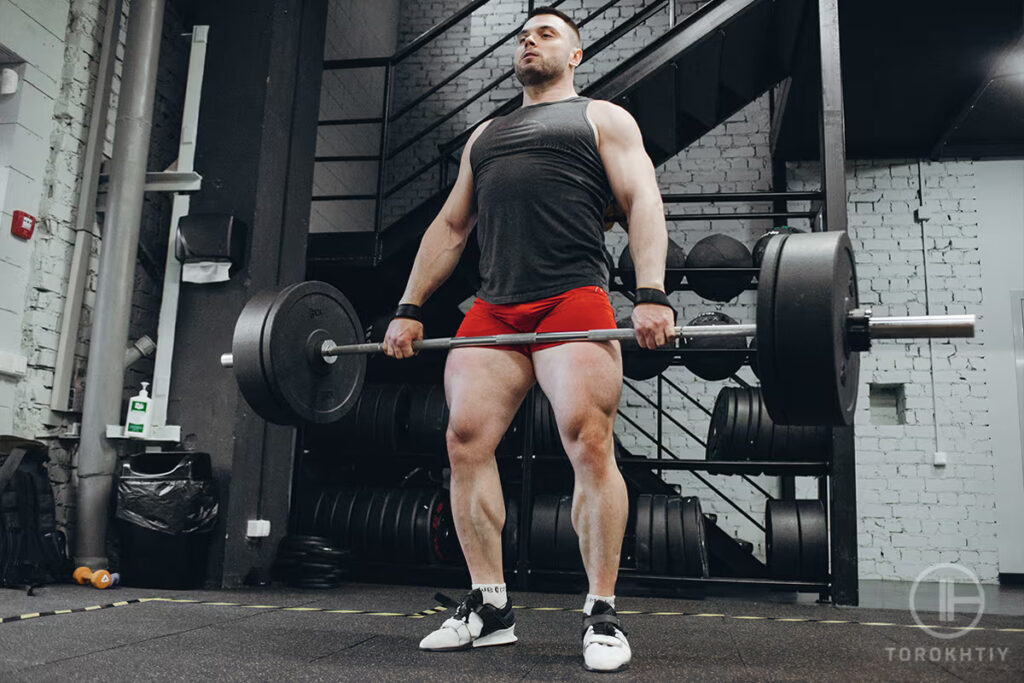
2. Grip Role In Everyday Life
A strong grip is not only important for sportsmen but also for anyone who wants to know how to increase grip strength and improve their overall health and well-being. Since the muscles in your hands and forearms play a crucial role in many everyday activities, e.g., carrying bags to opening a can, turning door handles, writing, and even getting dressed.
With regular training of your hands and improving grip strength, you can mitigate developing chronic pain and discomfort in the hands and forearms.
Additionally, the hand and forearm muscles are connected to the shoulder and upper back muscles. So, by strengthening them, you can improve your overall posture and mitigate the risk of developing posture-related injuries or discomfort.
Exercises for Grip Strength
The more you maintain your grip strength, the slower the cells age. If you don’t maintain your grip strength, the cells actually start to metabolize and age faster. So, the simplest way to strengthen your hands is to modify the exercises you already perform.
Meaning, to strengthen your grip you can perform those exercises using another grip technique and add extra exercises targeting specifically grip functionality.
Follow us!

Free!
Get a 2-week Weightlifting Program as a bonus for the subscription to kickstart your training plan!

Free!
Compound movements are exercises that require the use of multiple joints, regardless of the weight load, e.g., back and front squats, power cleans, snatch, deadlifts, bench press, incline press, or barbell rows. These exercises target a specific muscle group, by engaging most the entire body as well.
Known as assistance exercises, auxiliary exercises target smaller muscle groups focusing on a singular muscle instead of a large group of muscles. The samples of such exercises can be bicep curls, tricep extensions, leg extensions, shoulder presses, lateral raises, etc.
Here are a list of exercises that you can do to improve grip strength at home or at the gym as the majority of them mimic the movements you perform daily.
1. Compound Exercises
Keep in mind that your grip strength reflects the strength throughout your body. Thus, while working out your hands and forearms, don’t neglect full-body training as well as dedicate some time for recovery.
Free-weight exercises that incorporate barbells, dumbbells, and kettlebells, are another option to arrange an effective grip workout, intentionally increasing your grip. For instance, when doing bicep curls, you can squeeze the dumbbells to work on grip strength, specifically training your forearms and biceps properly.
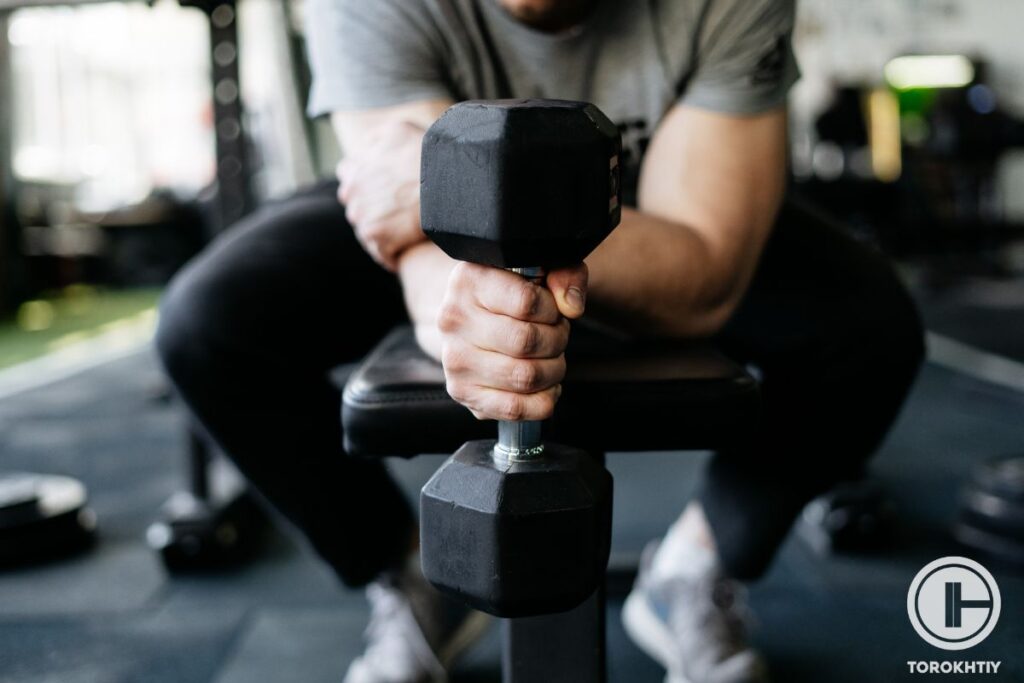
Compound exercises are movements that involve more than one muscle group simultaneously. They allow you to build a foundation for strength quickly, boost your dynamic flexibility, range of motion, and coordination. They are vital for improving your performance in the gym.
You can do bodyweight compound moves with no equipment, or incorporate weights to work out your grip. Here are several samples of compound movements you can add to your training routine:
• Deadlift
Doing exercises like deadlifts will help you get better grip strength since it’s a total-body movement. Perform deadlift using an overhand grip that is believed being the classic and the most natural grip position that translates well into real-life activity.
Just simply grab the barbell overtop with your palms facing downwards, wrap it with four fingers, excluding the thumb until you feel you have a tight grip. Then, add your thumb alongside to secure the grip. It maximizes forearm and palm muscles leading to the increased grip strength.
• Push-ups
Facing down the floor, with your hands shoulder-width, you can fire up the muscles in your forearms responsible for grip strength. This exercise will improve the stability and contractive strength of the many smaller muscles building the forearms, directly translating to greater grip strength and forearm stability.
• Dead hang
Use a horizontal bar, e.g., for pull-ups, and hang with your thumbs around the bar as long as you can. Your hands should be fully gripped around it. Try to beat the duration the next time as you train.
• Rowing
Indeed, rowing can increase grip strength. The repetitive pulling movement of rowing oars against resistance requires a solid grip, which can help improve grip strength over time. This exercise strengthens the muscles in the arms, shoulders, and hands.
Also, rowing often includes applying straps or handles that bring extra demand on the grip muscles, therefore increasing their strength.
• Barbell levering
No need to put any weight on the barbell. This exercise is about building wrist control to promote your grip endurance, as well as overall strength in hands and forearms. It’s super easy to perform it: stand straight holding the bar in the middle with a neutral grip in your right hand.
Tip the front of the bar toward the ground and pull it back not allowing it to hit the floor. Do the same with the back of the bar. Perform this motion for 10-15 reps.
2. Auxiliary Exercises
There are other accessory exercises that you can incorporate into your training routine:
• Farmer’s carry
Work with the heaviest objects you can lift from the ground using your hands. The aim of the exercise is to walk as long as you can while carrying the weights, e.g., kettlebells, dumbbells. When you start to get tired, put the weight down, shake your hands, and continue doing it again.
Practice this exercise by walking with weights until your maximum grip strength is close to giving out. This movement targets such upper-body muscles like forearms, biceps, and triceps. The farmer’s walk exercise will improve your supportive and crushing grip strength and also improve your pinching strength.
• Rack pulls
Due to the reduced range of motion, you can use more weight than with regular deadlifts. It’s a great exercise if you want to improve your grip and lockout strength for standard deadlifts. It’s possible to apply different grip and stance widths to customize the rack pull to your body and training needs.
• Squeezing a tennis ball
It’s a great way to engage your wrist and finger flexors, improving your crush grip. You can use a foam stress ball for this exercise. It’s easy to perform this movement: hold the ball in your right hand with your palm face up and your elbow bent at a 90-degrees.
Clench the ball as hard as you can using your four fingers, but don’t use your thumb. Hold the squeeze for 5 seconds and release it. Clench and release 10 times.
• Reverse wrist curls
For performing this exercise you just need a barbell or dumbbell and a solid surface you can sit on. This exercise involves your forearm muscles to increase grip strength. You just need to sit upright on a bench, holding a barbell or dumbbell in both hands with palms down in an overhand grip.
Lean forward and rest your forearms on your knees. While keeping your forearms on your legs, lift the weight, bending your wrists back. Lower the tool slowly, by letting your wrists curl down.
• Plate pinch
You need several plates of different weights for this movement. This exercise helps in strengthening your pinch grip. How to perform it: stand with 10-lb weight plates in your hands resting against your calf.
Grab the plates, using four fingers on the outside and your thumb on the inside to pinch it. Hold the plates for 10 to 15 seconds before the rest. Repeat 10 to 20 times on each side, also you can increase the weight or walk while pinching the plates to add up some intensity.
• Kettlebell swings
This is high-intensity, low-impact exercise that activates the upper and lower body muscles, as well as your trunk. You can improve your cardiovascular fitness, strength, and endurance. Kettlebell swings target mostly muscles of the posterior chain, glutes, hamstrings, calves. Additionally, you can activate forearm muscles improving your grip strength.
• Zottman curls
This movement helps to build forearm strength. You need to take a pair of dumbbells in each hand, while your arms extend by your sides. Keep your elbows close to your body and your palms facing each other in a neutral grip. Rotate your palms outward, so that they are facing opposite of you.
Begin by curling the dumbbell up toward your shoulders while keeping your elbows in place. Once you reach your shoulders with a dumbbell, rotate the dumbbells with your palms facing outward.
Lower your dumbbells back down to your sides with your palms facing the ground. Continue alternating curling with palms facing up and down as many reps as you can.
• Dumbbell shrugs
Add dumbbell shrugs to your training routine. This exercise imitates your movement when someone asks you a question and you’re unsure of your answer, but holding a dumbbell in each hand. It targets the traps mainly, the trapezius muscle that spans from the neck to the middle of the back, and across your shoulders.
You’re also working your rhomboids, as well as your forearms, and strengthening your grip. Thus, if boosting grip strength is your goal, this is a decent exercise to perform. Building strong traps will facilitate your strength during deadlifts, overhead presses, rows, and pull-ups.
• Standing cable row
Standing cable rowing involves many muscles in your back, namely the latissimus dorsi (lats), rear deltoids, trapezius (traps), and rhomboids. This exercise separates itself from other variations as it places great tension on your core and lower body.
Since cable machines come with different attachments, e.g., rope, straight-bar, single-handle, v-bar, etc. So, you have different grip options, which challenge your hands and forearms in new ways.
By the way, the rope attachment is one of the most common options. Its biggest benefit is that it activates your wrist and forearm muscles greatly compared to other attachments, making it a superb way to challenge your grip strength.
• Finger ball pushes
Hold a ball, which is a little bit smaller than a soccer ball. Press down one finger into the ball going through each of your fingers. Repeat this grip strength exercise 3 times on each hand.
• Pull-ups
Pull-ups are a good exercise to challenge your arm, shoulder, and back muscles, strengthening your support and crush grip. If this exercise seems challenging to you, you can start with dead hangs before mastering your pull-ups.
Standing under the pull-up bar with straight back, grab the pull-up bar with an overhand grip and your hands slightly wider than shoulder-width. Bend your elbows and lift your body until your chin is slightly above the bar. Hold for a moment, avoid swinging your body. Then lower yourself down to the starting position.
3. Equipment to Improve Your Grip
To improve your grip while exercising, you can wear weightlifting gloves that will facilitate your grip, e.g., while working out on machines like lat pulldown.
Besides numerous exercises to improve grip strength, there are useful tools that will cope with it smoothly. If you’re a newbie in training grip strength, let’s start by using an accessory like a hand gripper. It’s quite difficult to close it fully, so therefore it’ll give you a great workout, by improving various hand muscles.
Hand grippers come with different tensions depending on your needs and capabilities. Hand grippers can be incorporated into your training routine as an add-on tool to the regular pull-up bar exercises.
There are also exercises for improving ‘supporting’ and ‘pinching’ grip. Pinching weight plates can be very useful for improving your pinch grip. All you need is two plates you need to hold together. Do this exercise till it becomes easy, then switch the plates for heavier ones or add more plates you can pitch with your hand.
If you want to improve your support strength, use barbells: hold it for a couple of seconds or minutes to improve your overall support strength and be able to undergo more intense training programs. Adding various hand grip exercises will ensure the development of all your hand muscles in a balanced way.
Another technique is hanging from a pull-up bar that aims to stretch the upper-body muscles, namely your arms, chest, and back. You can simply hang from a pull-up bar using a parallel, or front grip, or by using a wider grip (side-by-side) for a minimum of one minute. You should try to go for more time to push your limits with each set.
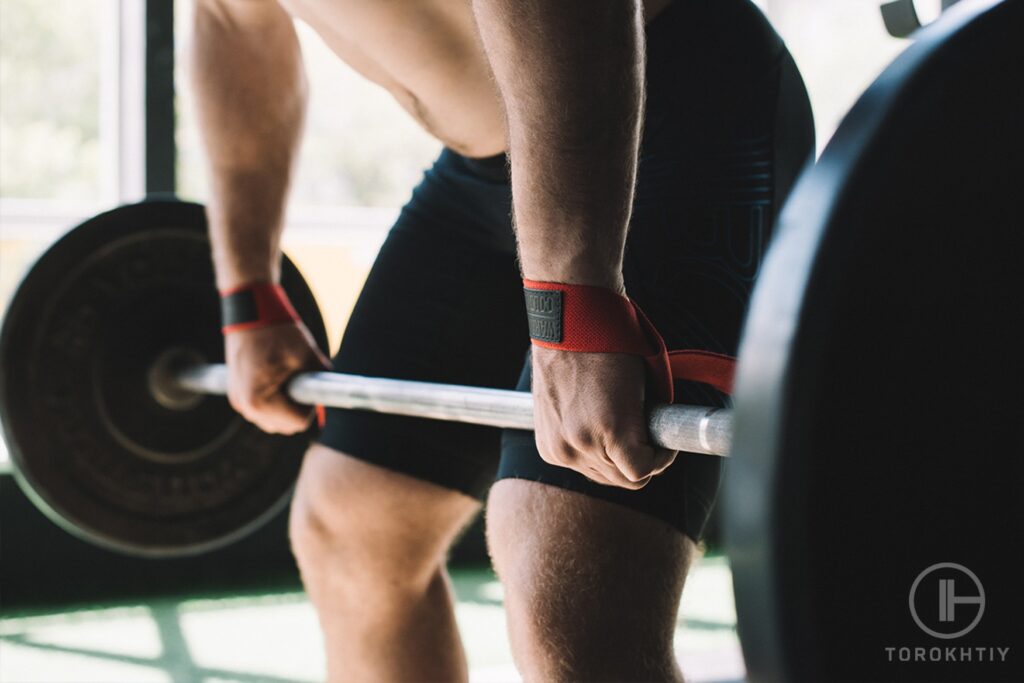
You can also apply fat grips by attaching them to your barbell, dumbbells, or pull-up bar to increase the diameter and involve more of your forearms and fingers, helping to build grip strength [5].
There are numerous grip strength trainers on the market to develop hand, forearm, and finger strength, as well as improving dexterity: pinch pin exerciser, strength trainer with adjustable resistance, silicone hand expander, finger grip stretcher, etc.
Grip-building pads that are wrapped around the barbell, increase the diameter of the handle for you to grip for your specific exercise. This results in greater muscle activation in your hands, forearms, and upper arms.
Fitness power balls is another alternative to developing a stronger grip – this is a tool made specifically to help climbers improve their grip strength.
How to improve grip strength?
There are several ways on how to improve grip strength with the help of particular exercises, specific tools, and grip methods. Let’s observe these approaches for you to define the best option.
1. Progressive Overload
Like other muscle groups, the muscles responsible for grip strength work better with progressive overload. This means a gradual increase in the resistance and duration of your exercises to challenge your muscles and facilitate their growth.
It’s recommended to start with the right resistance/ tension. You’d better choose the level that enables you to perform each movement with proper form and without excessive pressure. It should be challenging enough, but manageable.
Next, you should increase exercise duration and repetitions. Once you can comfortably perform an exercise for a specific period and it no longer feels challenging, it’s time to progress and add more reps or sets.
The key point is to push yourself hard and go beyond your comfort zone with each training session. This way you’ll improve your grip strength, adapt it to new loading and make it grow stronger.
Considering the statistics, it’s expected that a peak strength of a hand grip may occur around your mid-30s. Then this indicator slowly decreases and eventually levels out.
Taking into account the average grip strength, there’s a tendency for right-handed people to have a stronger grip with their left and vice versa. It may be surprising as you may think that a ‘dominant’ hand would be stronger.
If you are looking to maintain your current grip and improve its mobility, you can incorporate the following grip strength workout:
- wrist stretching will help to keep your joints and tendons loose, especially if you are constantly typing at a computer all day, so your wrists get tight and you start feeling discomfort;
- grip training rings are perfect for promoting hand grip strength, improving blood flow, and finger dexterity;
- finger strength exerciser, which may come in different resistances making this suitable for improving your extensor hand strength, or rehabilitating your hand and fingers after a strain or injury.
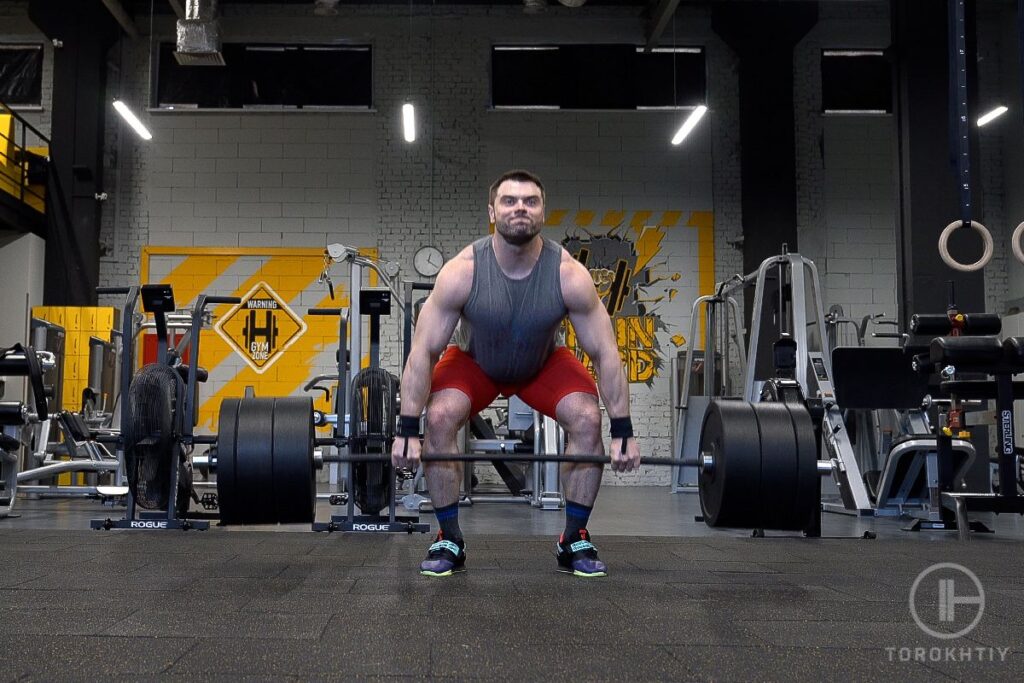
2. Grip Strength Training for Competitions/Sports
• Team and Single-Player Sports
Despite the difference between making or missing a catch, throwing the ball, or delivering a serve, grip strength is a crucial aspect for many sports, e.g. baseball, hockey, tennis, or football.
Athletes practicing boxing, judo, or ice hockey face contenders who try to break their grip and maintain their own at the same time. Thus, maintaining the grip strength becomes highly essential.
For example, baseball players understand the critical role of grip strength: it’s essential for pitching, batting, or catching the ball. A well-developed grip provides proper control over the ball’s speed and trajectory, or to produce the raw power to achieve greater batting distances and preserve consistency.
Even in endurance sports like rowing, grip strength plays an irreplaceable role in maintaining constant and efficient rhythm.
• Climbers
understand that developing grip and finger strength is crucial to conquer the toughest climbs.
You should focus on prioritizing forearm and grip strength as they’re essential for tackling lengthy climbs efficiently. It’s also recommended to use such equipment and grip exercises as free weights, hang boards, pull-up bars, and rope climbing to enhance endurance and overall climbing performance.
Barbell finger curls are an exercise used to isolate and increase forearm muscles and improve grip strength. It’s important to work with light weights and keep proper form. For climbing, this exercise can help to build grip strength and endurance for climbing.
Dead hanging on a pull-up bar brings many benefits: increasing grip strength, by stretching the muscles in your forearms, hands, core, shoulders, and back, and also decompressing the spine. This movement can help to develop forearm strength to lift yourself over the climb top.
Wrist rotation, or dumbbell forearm rotation, is a useful grip strength exercise that involves hand flexors and extensors while training biceps. It also strengthens the stabilizing muscles in the wrists.
This is a great option for warm-up and stretching before you begin a climb. It leads to increased blood circulation and less tension during climbing, which mitigates muscle injury.
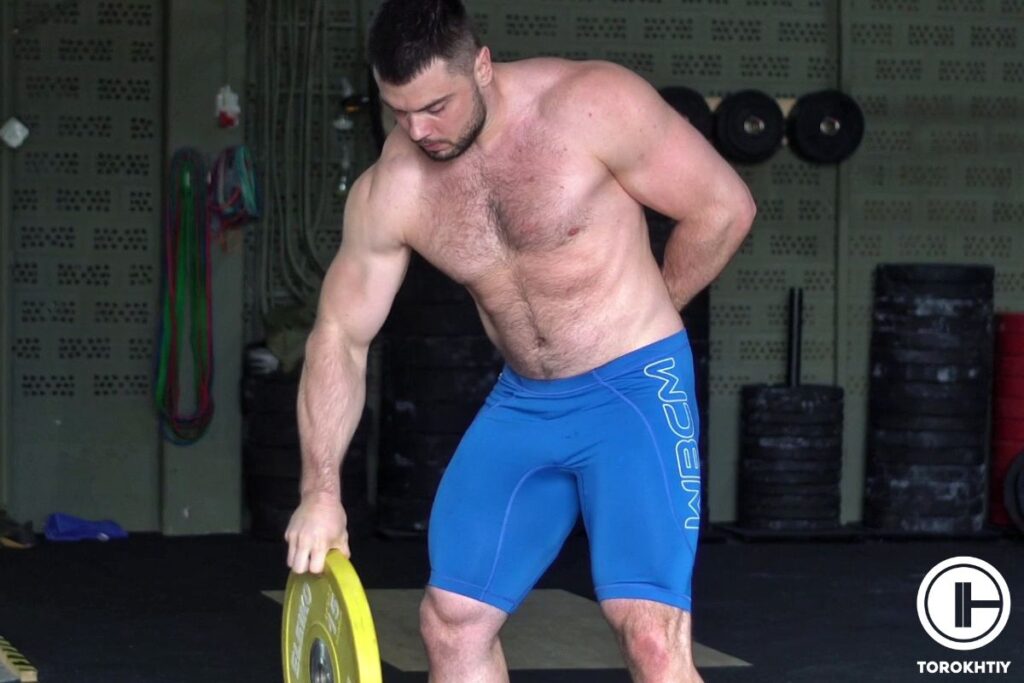
• Lifters
For those athletes who train with weights, one of the easiest ways to strengthen hand grip is to reduce the use of lifting straps [3]. It’s better to start with slow lifts like stiff-legged deadlifts and rows.
Pull-ups are an isometric contraction of your forearms, upper back, and core muscles. This exercise improves grip strength and pull-up capabilities. If you can’t hold yourself at the top position of a pull-up, use an assistance band that will help you control the hold while maintaining proper form.
The deadlift is a movement for building strength in your legs and lower back. You need good grip strength to hold the bar through the entire range of motion. With each deadlift rep, you can work on your grip strength to become stronger.
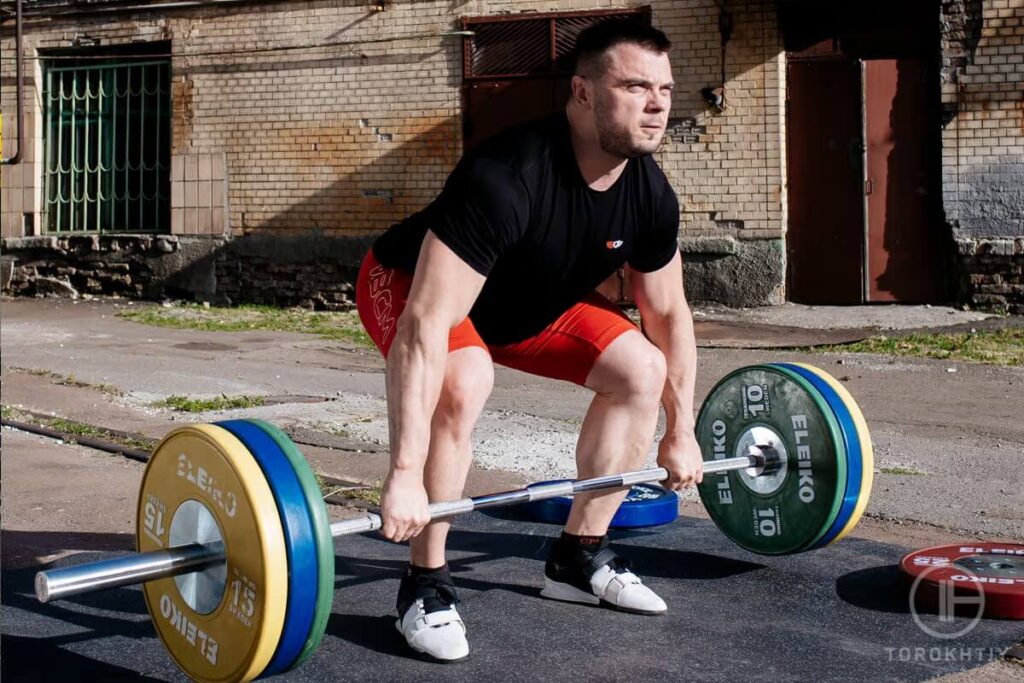
Try to lift barefoot, in flat shoes, or deadlift shoes. Shoes with a higher heel will give you more height to lift the bar and angle you forward.
• Martial artists
A strong grip has a protective effect for MMA fighters as it keeps their hands healthy and prevents potential injury.
In MMA, the most common grips are support, monkey, or clamp grips. The reason is that you can’t grab clothing, and all gripping movements are performed by grabbing your opponent or your own hands. So, it makes sense to focus on developing strength in these particular gripping techniques.
For instance, the study showed that judo athletes presented higher maximal absolute and relative strength and strength-endurance performance, lower strength mean fatigue index and muscle coactivation, only in the dominant hand, during the isometric strength-endurance handgrip test [4].
Working out full-body strength, particularly grip strength, can benefit you significantly in martial arts. These exercises will help you to strengthen your grip and promote general performance:
- Rope/Towel Pull-up. Adding a towel or rope turns the standard pull-up into an effective exercise making your hands and forearms burn. You also can perform it with added weight.
- Double Overhand Deadlifts. Performing deadlift variations is a must for MMA fighters. Conventional deadlift, with a trap bar, or Romanian deadlift, especially with a double overhand grip will challenge your grip much better than using a mixed or hook grip.
- Bottoms Up Kettlebell Press. This is quite a challenging grip exercise that involves balancing a heavy end in your hand. If you want to add some extra tension, perform carries with the kettlebell in the top or bottom position.
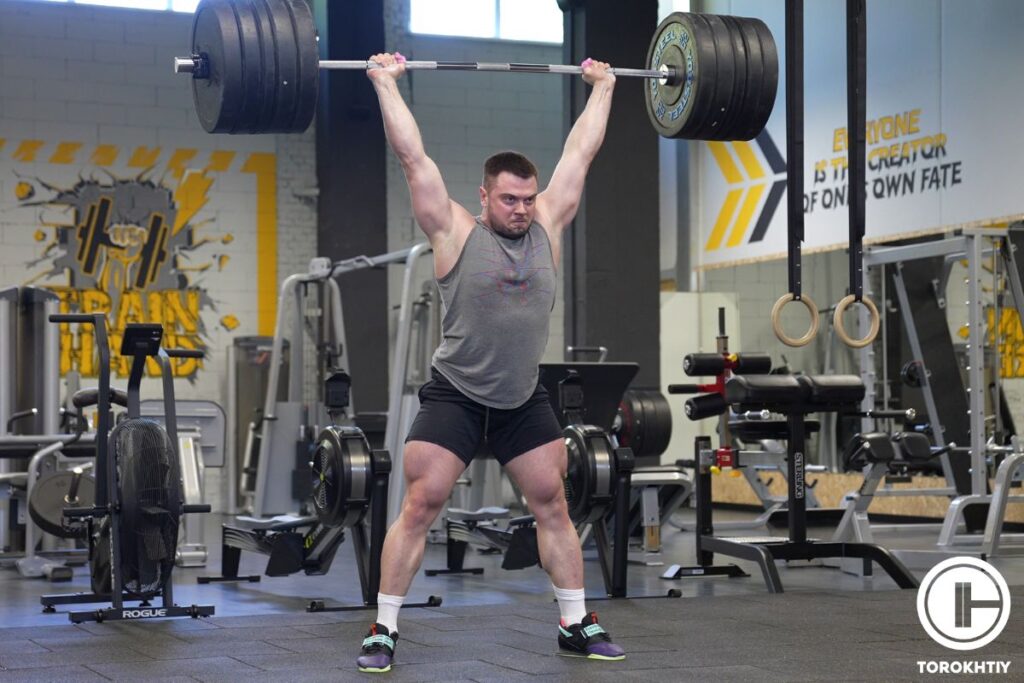
Grip Strength Assessment
A hand dynamometer is a specific device that measures grip strength [1]. This is a handheld device you should squeeze as hard as you can to define your grip power. To get precise results, it’s recommended to squeeze it three times on both hands.
It’s recommended to measure grip strength by doing a dead hang on a bar, squeezing something isometrically for a certain length of time, or testing it with pull-ups and tracking your progress. All in all, consistency is the most important point, especially when you aim to develop muscles.
1. Types of grip strength tests
Additionally to a dynamometer, to get a truer indication of grip strength, you can try another test – a pinch strength one that aims to measure the maximum isometric strength of the hand and forearm muscles when performing a pinching motion.
You also can test your grip strength with the help of a scale. You need bathroom scales, a pull-up bar, and a stopwatch. Put the scale underneath your pull-up bar or board. It should be high enough, with your arms fully extended.
You need to test your grip strength for 5 seconds. Set your stopwatch to 5 seconds, get in the right position, stand on the scale, and place your hands on the pull-up bar. Look at the scale to measure the weight.
Then squeeze the bar with your maximum strength. To test your grip strength you need to know how much weight you can carry by squeezing your hands. Stand with your feet flat on the scale, and squeeze your hands around the pull-up bar as hard as you can. Don’t bend your elbows, wrists, and knees.
Your body should remain stable. You need to lift as much of your body weight off the scale as you can using only grip strength. Measure the weight on the scale, it will be less than your body weight. It’s better to do several tests to get an average result.
If you have no specific tools and equipment to measure your grip strength, there are alternative ways to do it:
- ‘Object Lift and Hold’ test: take an item with a known weight. Lift and hold it with your arm extended as long as you can maintain the grip. The longer you can hold it, the stronger your grip.
- ‘Squeeze and Release’ test: take a soft, flexible ball and start to squeeze and release it repetitively, for instance, for one minute. The more successful squeezes you do, the more solid your grip is.
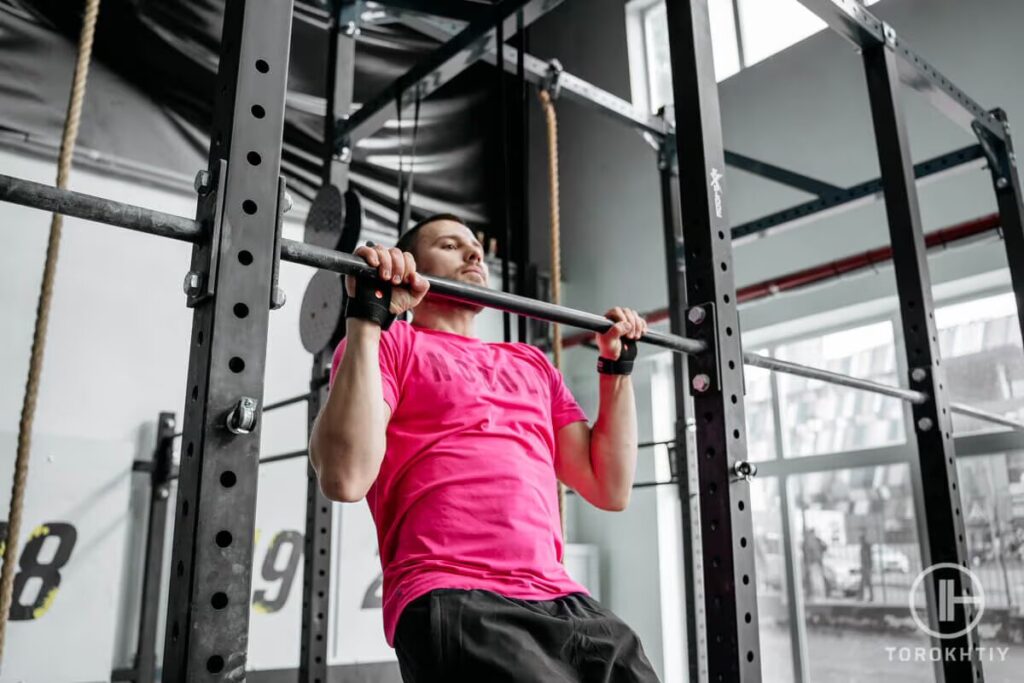
2. Setting a baseline for progress – what you can measure you can control
If you want to track your progress properly, you need to set baselines that is a landmark from which you can measure some changes. Without it, it can be problematic to define whether you’re making progress or not.
There are numerous things you can use as a baseline to track your progress: your current state, your destination, or the desired condition.
- Set particular and measurable goals.
After establishing your baselines, set specific goals that you want to gain. They should be aligned with your destination and reflect the desired impact you want to make. - Define a regular training routine and reporting schedule.
Consistency is the key to successful progress tracking. Work out regularly, monitor, and measure your results and effort. - Assess and interpret your data.
Don’t forget to analyze and interpret your training data to get valuable information on your physical condition and grip improvement. Consider your metrics to understand what exercises are working better for you and what needs improvement.
3. How to incorporate grip training into your routine?
All in all, it won’t become an issue to incorporate grip strength exercises into your training routine. The foremost thing is to prepare all the essential tools for your workout. Then, you should go over the exercises you can perform at home or at the gym to strengthen your grip.
Include exercises that incorporate carrying heavy weights, e.g., dumbbells or kettlebells, to improve grip and overall strength. Adding some resistance training, particularly bodyweight movements, is also a great way to improve grip strength.
Although, remember that grip strength isn’t just about brute power. Good motor skills are also vital, so perform exercises that require precision and control. Plate pinching can be a decent exercise to try. Extra accessories like various rope grips will add up some challenge to your grip and finger dexterity.
FAQ
Is 60-kg grip strength good?
For male athletes, the average grip strength is 105-113 lbs (48-51kg), a very good grip is 123-141 lbs (56-64 kg), while an excellent grip strength is around 141 lbs (64kg)
Can I train my grip every day?
Generally, yes, you can, but your training plan should be wisely structured not to hurt your hands and have time to rest. You can perform 1 or 2 warm-up sets, then perform 2 or 3 sets of moderate-to-low reps with maximum effort. It’s recommended to do such sessions 3 times per week.
Can hand grippers show veins?
Yes, this grip-training tool can make your veins visible. As it increases your grip power and muscles, hand vascularity may become more prominent. Although, it depends on the percentage of body fat, muscle mass, and genetics.
Conclusion
To conclude, if you’re looking for insights on how to improve grip strength, we advise you to start with simple exercises for your hand muscles to gain more endurance and become stronger. Adding several grip strength exercises and ways to incorporate them into your training regime will help you to develop a solid hand grip.
If you’re curious about how to promote your grip performance and make it more tension-resistant, write your comments below to get our expert tips to find out more ways to improve your grip condition.
References:
- Shu-Chun Lee, Li-Chen Wu, Shang-Lin Chiang. “Validating the Capability for Measuring Age-Related Changes in Grip-Force Strength Using a Digital Hand-Held Dynamometer in Healthy Young and Elderly Adults”, BioMed Research International, 2020: 6936879.
- Raju Vaishya, Anoop Misra, Abhishek Vaish. “Hand grip strength as a proposed new vital sign of health: a narrative review of evidences”, Journal of Health, Population and Nutrition. 2024; 43: 7.
- Marianne Huebner, Bryan Riemann, Andrew Hatchett. “Grip Strength and Sports Performance in Competitive Master Weightlifters”, International Journal of Environmental Research and Public Health. 2023 Feb; 20(3): 2033.
- Renêe de Caldas Honorato, Emerson Franchini, Jerusa Petrovna Resende Lara. “Differences in Handgrip Strength-Endurance and Muscle Activation Between Young Male Judo Athletes and Untrained Individuals”, Research Quarterly for Exercise and Sport, no. 92(1), (2021): 1-10.
- Cummings Patrick M.; Waldman Hunter S.; Krings Ben M. “Effects of Fat Grip Training on Muscular Strength and Driving Performance in Division I Male Golfers”, Journal of Strength and Conditioning Research 32 (1):p 205-210, January 2018.
- All photos are made by Torokhtiy Media Team
Why Trust Us?
With over 20 years in Olympic weightlifting, strength training, nutrition coaching, and general fitness our team does its best to provide the audience with ultimate support and meet the needs and requirements of advanced athletes and professional lifters, as well as people who strive to open new opportunities and develop their physical capabilities with us.
By trusting the recommendations of our certified experts in coaching, nutrition, and sports training programming, as well as scientific consultants, and physiotherapists, we provide you with thorough, well-considered, and scientifically proven content. All the information given in the articles concerning workout programming, separate exercises, and athletic performance, in general, is based on verified data.
The product testing process is described in more detail here.
Author: Sergii Putsov
Head of Sport Science, PhD
Best Results: Snatch – 165 kg,
C&J – 200 kg
Sergii Putsov, Ph.D., is a former professional weightlifter and National team member, achieving multiple medals in the 94 kg weight category at national competitions. With a Master’s degree in “Olympic & Professional Sport Training” and a Sport Science Ph.D. from the International Olympic Academy, Greece, Sergii now leads as the Head of Sport Science. He specializes in designing training programs, writing insightful blog articles, providing live commentary at international weightlifting events, and conducting educational seminars worldwide alongside Olympic weightlifting expert Oleksiy Torokhtiy.



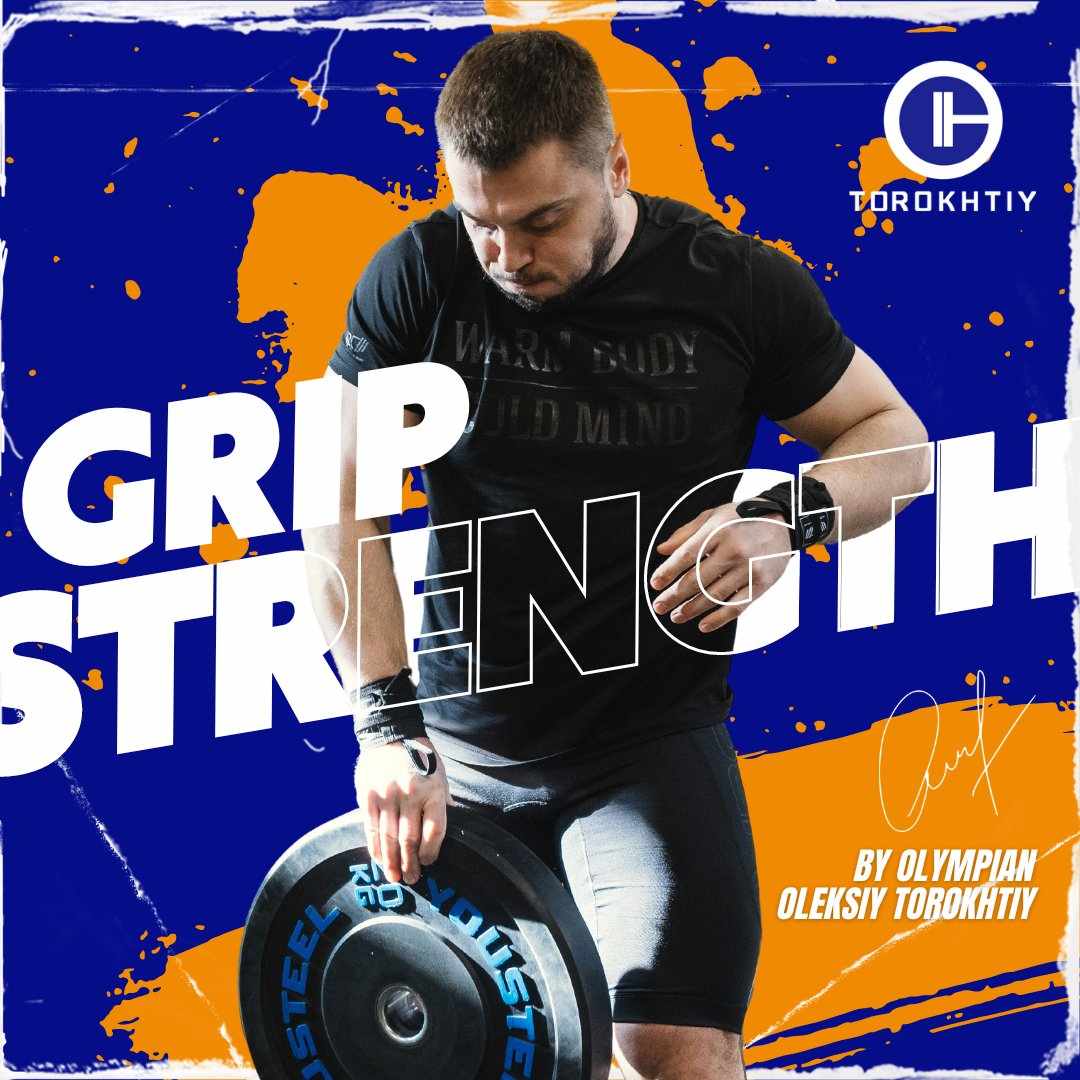
Still have questions after reading our article? Unlock your full potential by engaging with our experts and community! Don’t hesitate — leave a comment below and Sergii Putsov will provide a personalized answer and insights to help you reach your goals.